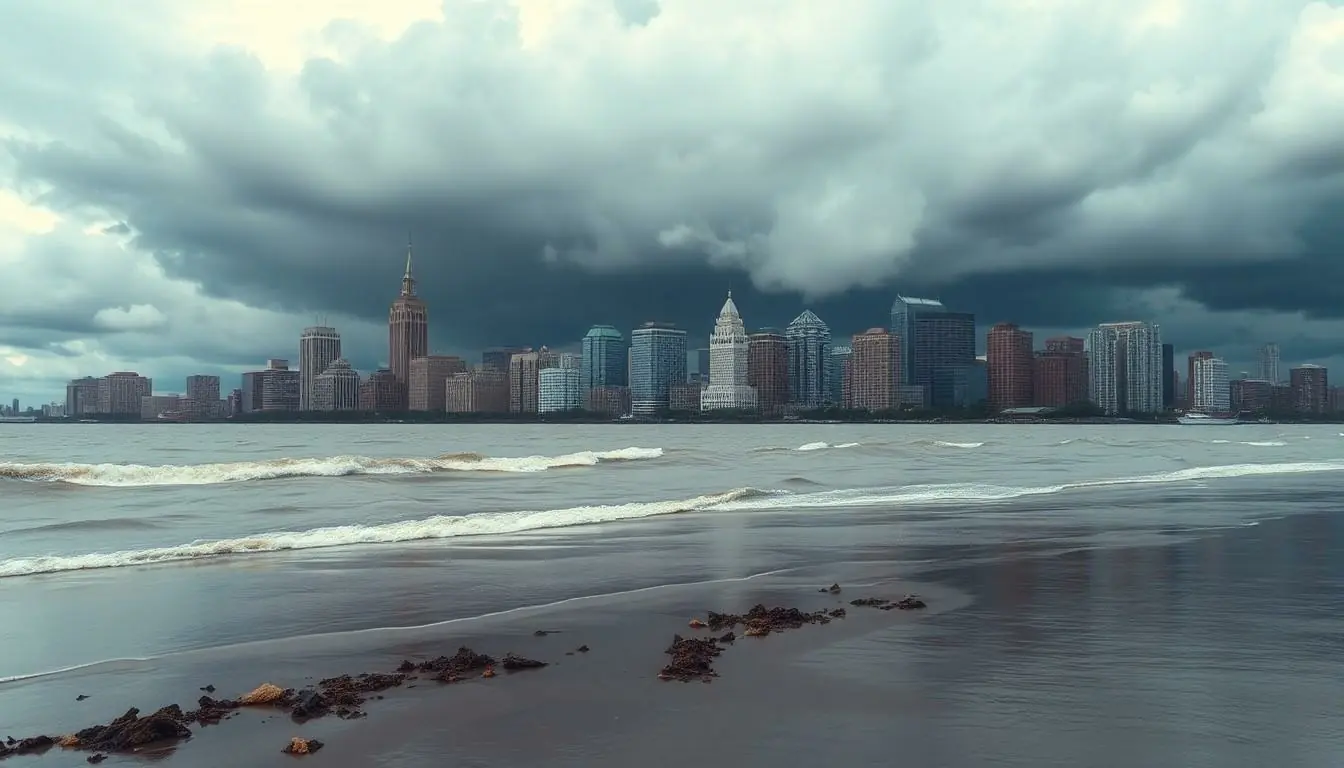Global climate change isn’t just a buzzword tossed around at dinner parties; it’s a reality that’s knocking on everyone’s door—often uninvited. Imagine a world where your favorite beach is now a swamp and summer vacations turn into ice skating adventures. Sounds like a plot twist in a bad sci-fi movie, right? But this is the potential future we face if we don’t pay attention to the effects of climate change.
In scenario 1, the implications are as serious as a cat in a dog park. From rising sea levels to unpredictable weather patterns, the consequences are both alarming and, dare we say, a little ridiculous. Understanding these effects is crucial, not just for our planet but for our sanity. So, let’s dive into the possible impacts and see what’s at stake if we don’t take action.
Table of Contents
ToggleOverview of Global Climate Change
Global climate change represents a significant shift in the Earth’s climate patterns, primarily driven by human activities such as greenhouse gas emissions. Rising temperatures can lead to more frequent and intense heatwaves, affecting ecosystems and human health. Altered precipitation patterns result in severe droughts in some regions and increased flooding in others, impacting agriculture and freshwater supplies.
Coastal areas face heightened risks as melting polar ice caps contribute to rising sea levels. This phenomenon threatens low-lying communities and could displace millions. Changes in wildlife habitats due to shifting climates disrupt ecological balances, putting various species at risk of extinction.
Unpredictable weather events challenge infrastructure and emergency services. Human systems such as agriculture and water management struggle to adapt to these changing conditions. According to studies, climate change could have a direct economic impact projected to reach trillions of dollars annually as communities invest in disaster prevention and recovery efforts.
The increasing frequency of natural disasters showcases the urgency of addressing climate change. It is evident that global cooperation and policy reform play critical roles in mitigating its effects. Understanding these outcomes emphasizes the need for immediate and sustained action to protect our planet from further degradation.
Scenario 1 Analysis

Scenario 1 highlights the significant impacts of global climate change through various effects on the environment and society. It emphasizes how shifts in climate patterns disrupt ecosystems and human activities, showcasing the need to understand these changes.
Description of Scenario 1
In this scenario, rising sea levels pose a considerable threat to coastal cities and vulnerable communities. Weather patterns become increasingly erratic, leading to more intense storms and prolonged droughts. Coastal erosion accelerates, altering landscapes and habitats. The effects on agriculture appear severe, with changing precipitation patterns affecting crop yields. Moreover, public health risks increase due to heatwaves and the spread of vector-borne diseases. Each of these changes illustrates the urgent and interconnected challenges communities face.
Key Factors Influencing Effects
Several key factors drive the effects observed in Scenario 1. The rising concentration of greenhouse gases directly impacts global temperatures. Increased ocean temperatures contribute to stronger hurricanes and extreme weather events. Urban development in vulnerable areas exacerbates the risks associated with flooding and erosion. Furthermore, deforestation reduces the Earth’s capacity to absorb carbon dioxide, speeding up climate change effects. Human behavior, including carbon-intensive practices, profoundly shapes these dynamics. Each factor underscores the complexity of climate change and its widespread implications.
Possible Effects of Global Climate Change
Global climate change presents numerous potential effects, each significantly impacting the planet and society. Various outcomes signal urgent attention and response.
Effect on Weather Patterns
Weather patterns undergo remarkable changes due to climate change. Increased atmospheric temperatures contribute to more frequent heatwaves and extreme precipitation events. A rise in hurricanes results from warmer ocean waters, leading to more severe storms. Erratic rainfall intensifies droughts and floods, disrupting agricultural operations and threatening food security. Regions once characterized by stable climates can experience unpredictable weather, challenging infrastructures and emergency services, which must adapt constantly.
Effect on Biodiversity
Biodiversity faces immense threats attributed to climate change. Species struggle to adapt or relocate as temperatures shift and habitats change. Altered ecosystems disrupt food chains, leading to significant declines in populations of vulnerable species. Coral reefs, for example, suffer from increased ocean temperatures and acidification, resulting in coral bleaching and loss of marine life. Loss of biodiversity leads to diminished ecosystem services, directly impacting human livelihoods and well-being.
Effect on Human Health
Human health experiences serious repercussions stemming from climate change. Heatwaves increase the risk of heat-related illnesses and deaths, particularly among vulnerable populations. Altered weather patterns contribute to the spread of vector-borne diseases like malaria and dengue fever. Poor air quality exacerbates respiratory issues, creating additional burdens on healthcare systems. As communities confront these escalating health risks, greater demand for medical resources and public health initiatives arises.
The effects of global climate change as illustrated in Scenario 1 are profound and far-reaching. Rising sea levels and unpredictable weather patterns pose significant threats to coastal cities and vulnerable communities. The challenges extend beyond environmental concerns, impacting agriculture, public health, and overall societal stability.
As these changes unfold, it becomes increasingly clear that proactive measures are essential. Addressing the root causes of climate change through collective action and policy reform is crucial for safeguarding the future. The urgency of the situation cannot be overstated, as the interconnected nature of these challenges demands immediate and sustained efforts to ensure a livable planet for future generations.




